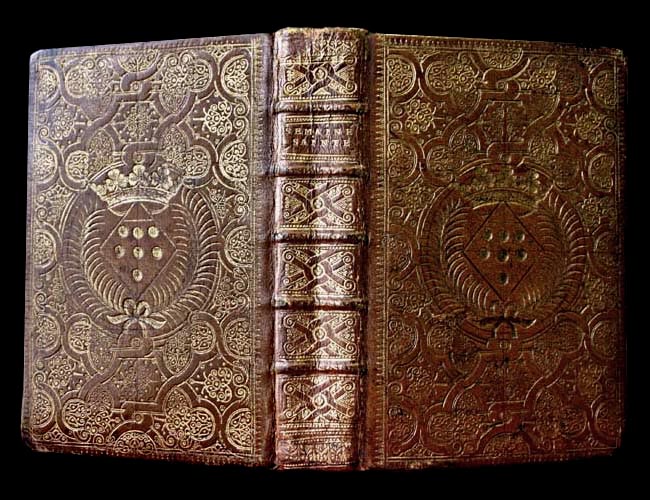

|
This is the third example of a Antoine Dezallier 1715 printing of the Office de la semaine sainte in a Atelier des Caumartin binding. By a stroke of good luck, I found this binding by searching the internet for images associated with the name Dezallier. This binding is featured on a web page as a part of an exhibition of the Astrolabe - Médiathèques et Archives de Melun. Finding three 1715 Dezallier examples with Caumartin bindings confirms with certainly that the Atelier Caumartin activity did extend far beyond the dates proposed by Ralphael Esmerian. I quickly sent off an email to the Astrolabe to ask for more photos and was elated to get a reply from Francine Lepetit who was kind enough to forward some excellent photos by Mathieu Regnault. This binding which in many ways has been executed in an identical fashion as the two other examples, is framed by a different outer roulette. By a strange coincidence I had just been working on a comparative study of a similar looking roulette, found on the doublure of a 1667 NTM, which appears to be the work of Luc-Antoin Boyet. Up to this point I had found no obvious imprint links between the Caumartin tools and those of Boyet. However the curious fact that Boyet started working as a binder around about the same that Esmerian attributes to the beginning of the second phase of Caumartin activity, i.e. 1685 is also to be considered. Boyet eventually became the royal binder, and as many of the Caumartin bindings bear royal arms one would think that they ought to be the work of the royal binder. Still, in the main it would appear that the work of Boyet does not match up well with the distinct style of the atelier des Caumartin bindings. |
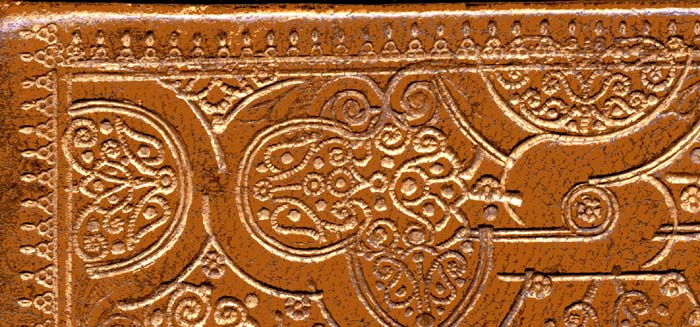
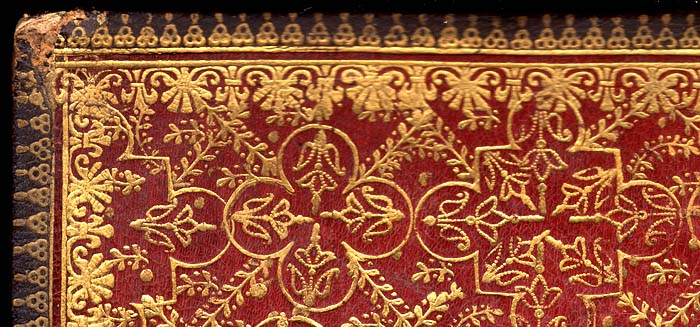
| After a number of attempts to find distinctive features in the Boyet roulette and then comparing the results with Mathieu Regnault's photos of the Melun example, I found that the two imprints of this outer roulette were indeed very similar, and asked Francine Lepetit for yet another favor, what I needed was a high resolution 1200 dpi scan. Variations in imprint quality, as well as differences in the direction of the light source make comparative identifications a tricky business. However high resolution images can sometimes provide irrefutable proof. |
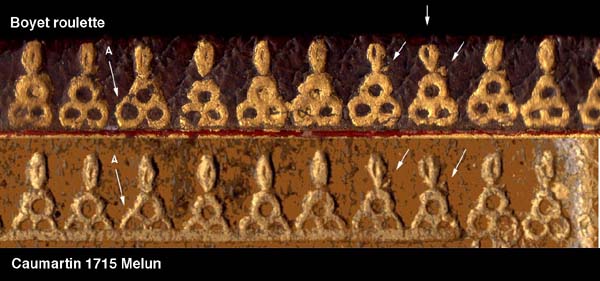
|
In Comparative Diagram 1, at point "A" I have marked one of the few obvious components of the Boyet roulette which differs from the others, this lower ring appears larger than most and is quite easy to locate in most of the imprints. Not far from this big ring are found two units which appear to have a "chip on their shoulder" these chips reflect the light well and are quite easy to see if the light source is not overly angular. These small details have been marked with arrows, however the most distinctive comparative feature is the hole or lack of a hole in the crowning plumes. A close comparative study of these details leaves no doubt that the two imprints derive from one and the same tool. What is the significance of finding a Boyet tool amongst those of the Atelier des Caumartin? When I was researching the NTM doublure, a Google search of "Luc-Antoine Boyet" came up with the name of Jeanne-Marie Métivier who has written a short paper entitled Luc-Antoine Boyet, relieur de l'Imprimerie royale (1704-1723) which was published in la Revue de la Bibliothèque nationale de France, numéro 12, 2002. I wrote to the BN asking them to forward my email to her in which I enclosed images of the NTM doublure. My research on this binding led me to the conclusion that it is almost certainly the work of Boyet, however I was keen to have the opinion of someone who by all accounts, must an expert, one of a very few in the world. In due course Jeanne-Marie Métivier sent a very interesting reply, part of which has a direct bearing on this issue.... "Je ne peux que vous encourager à lire mon article paru dans le numéro 12 de la Revue de la Bibliothèque nationale en 2003, car j'y traite de ce problème des attributions de reliures à Boyet sans preuve. C'est le cas du catalogue Esmerian, et du catalogue d'exposition rédigé par Isabelle de Conihout et Pascal Ract-Madoux dont vous reproduisez les reliures. Ils ne démontrent pas que Boyet est l'auteur des reliures, ils le suggèrent en parlant de fers du doreur de Boyet, mais sans citer de sources. De même les affirmations des catalogues de vente ne sont pas fiables. En conclusion, il faut être très prudent." here a very rough translation of this part of her reply... "I can only encourage you to read my article, because it deals with the problem of bindings attributed to Boyet without proof. This is the case with the Catalogue of Esmerian and the Exhibition Catalogue of Isabelle de Conihout et Pascal Ract-Madoux. They do not provide proof that the illustrated bindings are the work Boyet, they (Isabelle de Conihout et Pascal Ract-Madoux) speak of the tools of the guilder of Boyet, yet do not site their sources (for this information). It is the same problem with Auction Catalogues, the information given is not reliable. In conclusion, then, one must be very prudent." I should mention here that the Catalogue of Isabelle de Conihout et Pascal Ract-Madoux, lavishly illustrates nearly two dozen examples of bindings which they have attributed to Boyet as well as rubbings of the more important tools, while there are nearly as many in Esmerian's catalogue. Imagine then about 40 binding examples attributed to Boyet... by some of the top experts in the field... one is tempted to think that at least some of these bindings may have been executed by Boyet?... in fact, I think it is more likely that most of these bindings can be associated with Boyet. It has often been suggested, is that while Boyet may have been the binder it is not certain that he was also the guilder of these bindings. What ever the case may be, the important thing to keep in mind is that even the experts are not agreed when it comes to identifying a binding by Boyet. The discovery of any new element could therefore be very important, in this regard I would like to point out the decorative gold foil past-down that is found in this Melun example as well my 1715 example. |
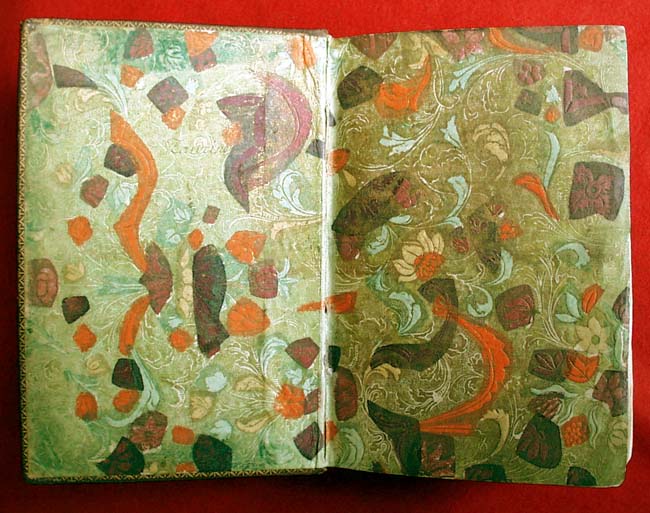
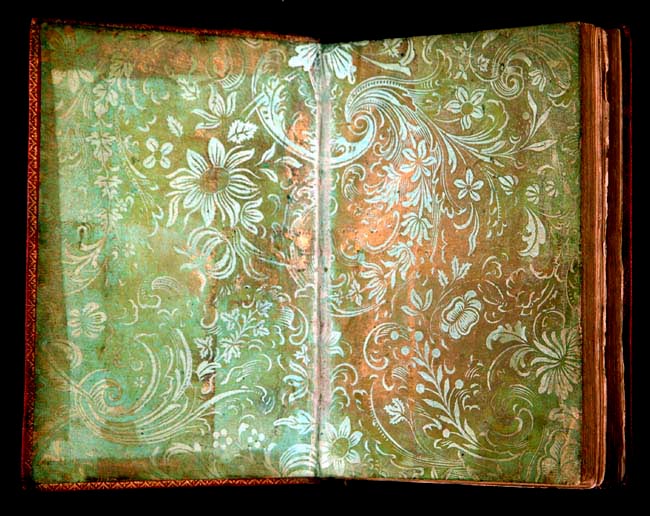
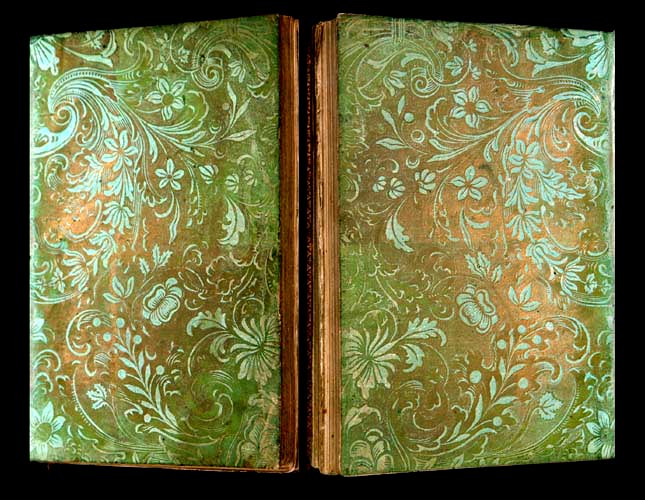
| Note that although the reversed design appears to be an exact mirror image, it is not. The reversed image has been carefully, but not perfectly copied. This gives some idea of the care that has been given to the actual design as well as the artists ability to reproduce a nearly identical pattern. |
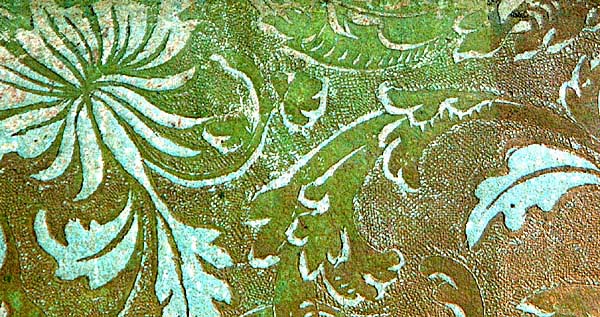
| In the photos above I have tried to reproduce the reflective quality of this elaborate paper or foil, which appears to be covered with a painted layer, the gold under-layer only plainly visible where the upper layer has worn away. It may be that this paper is a rare early example of Brocade paper. |
| A distinctive feature of brocade paper is an embossed structure pressed into the paper by means of real or imitation gold or silver foil. Thick plates or cylinders of copper were used, with the representation in positive or negative relief. In most cases uncoloured paper was used, but sometimes coloured paper or paper with a coloured design was used as the basis for such decorated paper. Later on, brocade paper was sometimes coloured by hand. It comes in all variations, from simple patterns to very intricate ones, while often the names and residences of the maker and the designer are found in the margin, together with its serial number. The first brocade papers were made in Augsburg around 1700. |
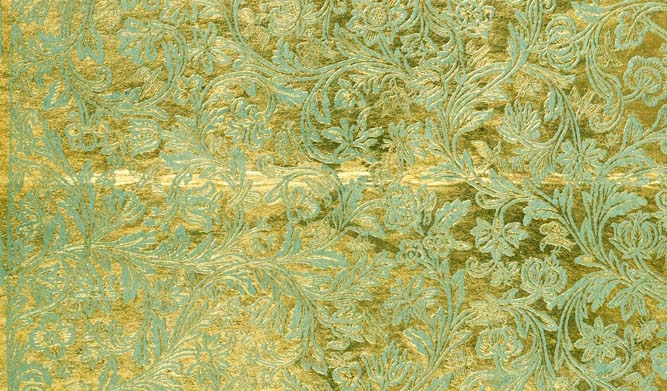
| Virtual Bookings, created by L. A. Miller | return to the Home page of VIRTUAL BOOKBINDINGS |